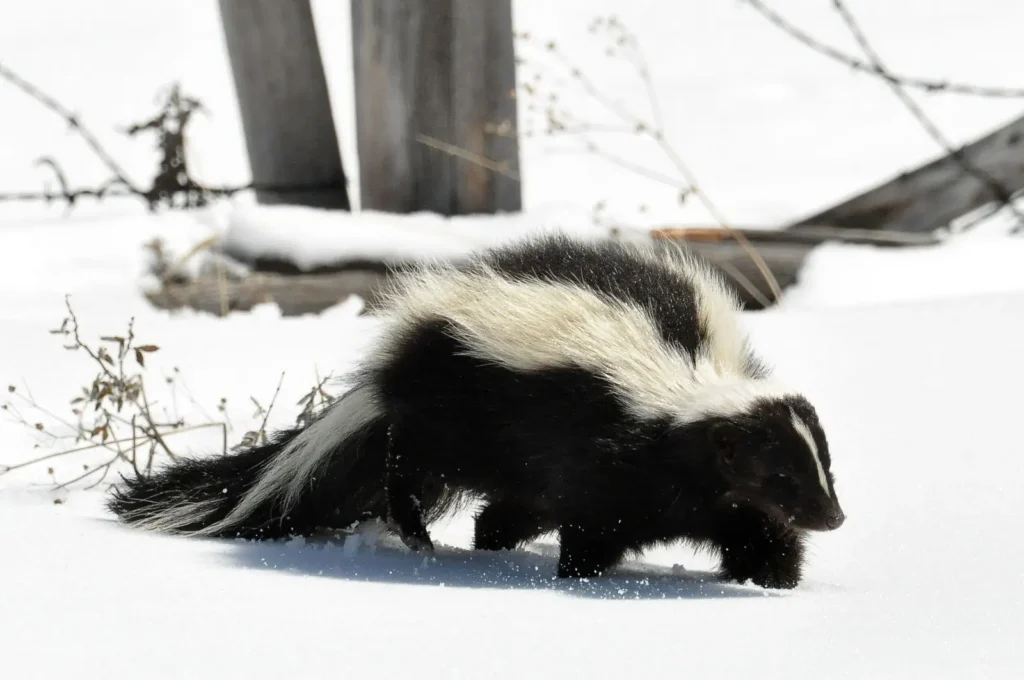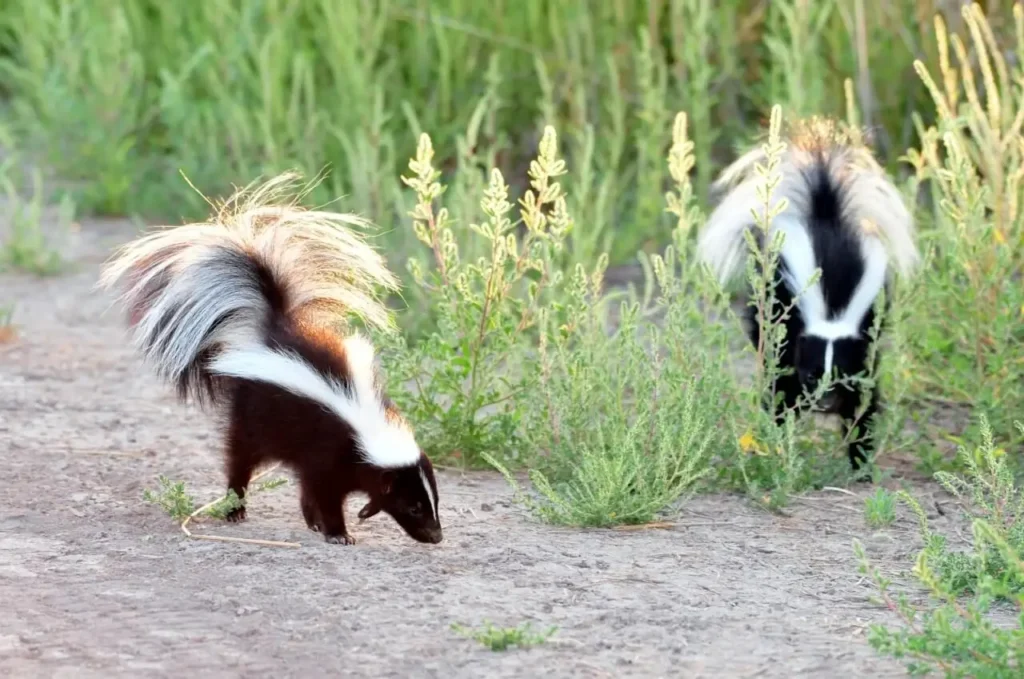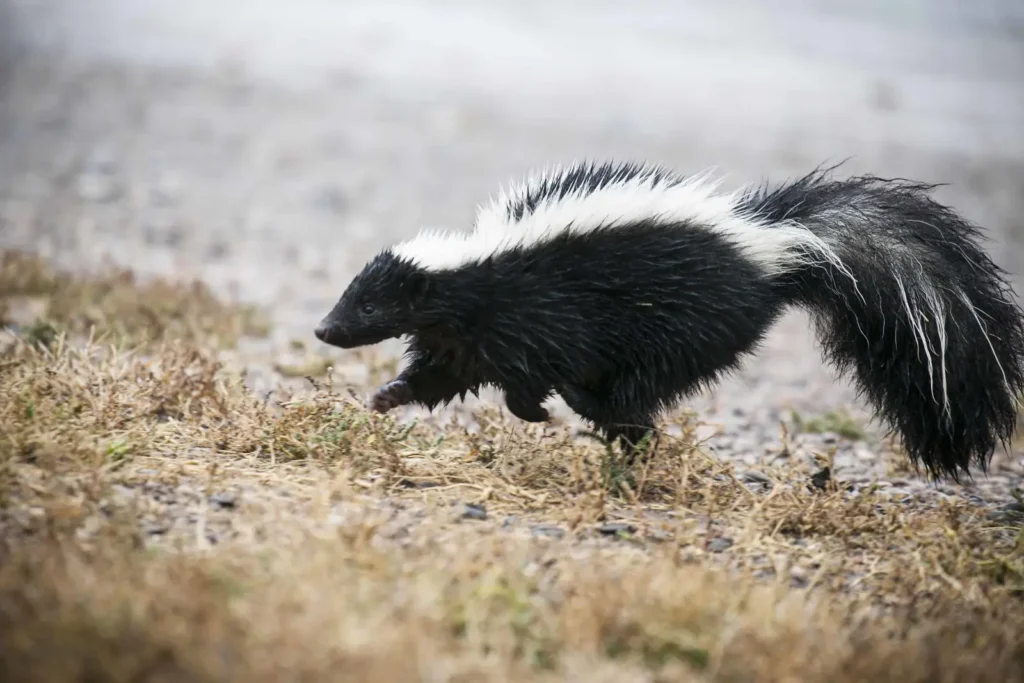Striped skunk (Mephitis mephitis) is a small carnivorous mammal from the skunk family (Mephitidae), known for its ability to emit a pungent and persistent odor as a defense against predators.
This animal is native to North America and has perfectly adapted to living in a variety of environments, including forests, fields, agricultural lands, and even suburbs. The skunk is predominantly nocturnal, hunting insects, small animals, and gathering plant foods.

Classification and scientific name
• The Kingdom: Animals (Animalia)
• Type: Chordal (Chordata)
• Class: Mammals (Mammalia)
• Row: Predatory animals (Carnivora)
• Family: Skunk (Mephitidae)
• Gender: Skunks (Mephitis)
• View: Striped skunk (Mephitis mephitis)
This species is the most common among skunks and is well known for its unique defense mechanism.
Physical characteristics
Dimensions and weight
📌 Body length: 30-40 cm
📌 Tail length: 15-30 cm
📌 Weight: 1.5-4.5 kg
Color and fur
✔ Main coat color: black
✔ Characteristic stripes: two white stripes along the back that can merge or separate
✔ Tail: fluffy, often with white hairs
The skunk's coloration serves as a warning signal to predators - black and white contrasting camouflage indicates its toxic defense.

Range and habitat
🔵 Spread
The striped skunk lives throughout North America:
• Canada - from the southern regions to the province of British Columbia
• USA - everywhere except the northernmost states
• Mexico - Northern and central parts
🔴 Living environment
✔ Deciduous and mixed forests
✔ Meadows and plains
✔ Agricultural land
✔ Suburbs and urban areas
Skunks easily adapt to living near people and often settle under houses, in sheds or old stumps.

Lifestyle and behavior
🌟 Social structure
✅ Mostly loners
✅ In winter, they can gather in groups to keep warm
🌟 Activity time
✅ Nightlife lifestyle
✅ They spend the day in burrows or shelters
🌟 Main behavioral features
✔ Avoids conflicts but is able to defend himself
✔ Before spraying stench, it warns the enemy - stomps its paws, bends its back, raises its tail
✔ May fall on its front paws, raising its hind body before spraying the secretion
Food and hunting
🍖 Omnivorousness is the main advantage
Striped skunk omnivorewhich hunts insects and small animals and eats plant foods.
✅ Typical food sources:
Insects (beetles, grasshoppers, caterpillars)
Rodents (mouse-like)
✔ Bird eggs and chicks
✔ Snakes, frogs, lizards
✔ Fruits, berries, mushrooms
✔ Root crops and seeds
💡 Methods of obtaining food
- Uses strong front paws to dig up the ground
- Breaks up insect nests (especially likes wasp and bee larvae)
- Hunts rodents by attacking suddenly
Protection and characteristic odor
🔴 The main defense is the anal secretion
The skunk has special anal glandsthat produce mercaptans - substances with a pungent odor.
💨 How does the defense mechanism work?
1. Warning. - The skunk stamps its paws, growls, and raises its tail.
2. The last chance - arches its back and stands on its front paws.
3. Spraying - directs a stream of secret at the enemy (range - up to 3 m).
4. The odor lasts for several days, and sometimes for weeks.
🛑 Predators avoid skunks because of this strong odor.
Reproduction and life cycle
❤️ Mating season: February-March
❤️ Pregnancy: 60-75 days
❤️ Number of children: 4-10 (usually 6)
❤️ Puberty: 10 months
👶 Babies are born blind, weighing only 30 grams.
👩👧 Mother feeds her cubs with milk for up to 8 weeks.
👨👩👦 Young skunks leave the burrow at the age of 2-3 months.
🧬 Life span: 3-5 years in the wild, up to 10 years in captivity.

Natural enemies and threats
🔴 Birds of prey and animals
✔ The great horned owl is one of the few enemies that is insensitive to smell
Foxes, coyotes (sometimes attack young skunks)
🔴 Threats from humans
✔ Habitat loss
✔ Deaths on the roads
✔ Pesticide poisoning
Protected status and rescue efforts
🟢 Security status:
🔹 View it is not under threat of extinction
🔹 The population is stable due to high adaptability
🟢 Security measures:
✔ Population control in settlements
✔ Protection of natural ecosystems
Striped skunk in culture
🎭 Symbolism and image in art
✔ Famous cartoon character Pepe Le Puy - the gallant French skunk from Looney Tunes
✔ Often appears in movies, comics, and advertising
Conclusion
The striped skunk is an incredibly interesting animal that skillfully combines agility, cunning, and effective defense. Its unique ability to spray scent has made it one of the most famous animals in North America.